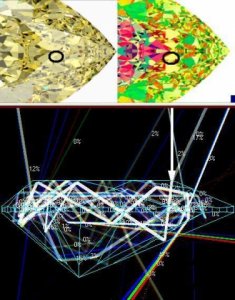- Joined
- Jan 7, 2009
- Messages
- 10,377
Is green bad in an aset?
I've heard that said on a number of occasions.
I'll use examples of stones that meet the guidelines for posting here on PS ( not available on our site)
I'll start with a marquise.
Here's my impression of how to interpret this aset, looking at the actual stone, and the aset image:
The green areas are "crushed ice" looking. That is to say, small virtual facets, flashing back a lot of pinfire. The aset does give a pretty good idea of the bowtie- which this stone does exhibit.
In any even, the tips of the stone- where there's a lot of green on the aset- are the "flashy" part.
Subjective : looking at the stone in person, I like the parts that show green on the aset

Below I've photographed the stone with the pavilion blocked to allow context.

I've heard that said on a number of occasions.
I'll use examples of stones that meet the guidelines for posting here on PS ( not available on our site)
I'll start with a marquise.
Here's my impression of how to interpret this aset, looking at the actual stone, and the aset image:
The green areas are "crushed ice" looking. That is to say, small virtual facets, flashing back a lot of pinfire. The aset does give a pretty good idea of the bowtie- which this stone does exhibit.
In any even, the tips of the stone- where there's a lot of green on the aset- are the "flashy" part.
Subjective : looking at the stone in person, I like the parts that show green on the aset

Below I've photographed the stone with the pavilion blocked to allow context.




















300x240.png)